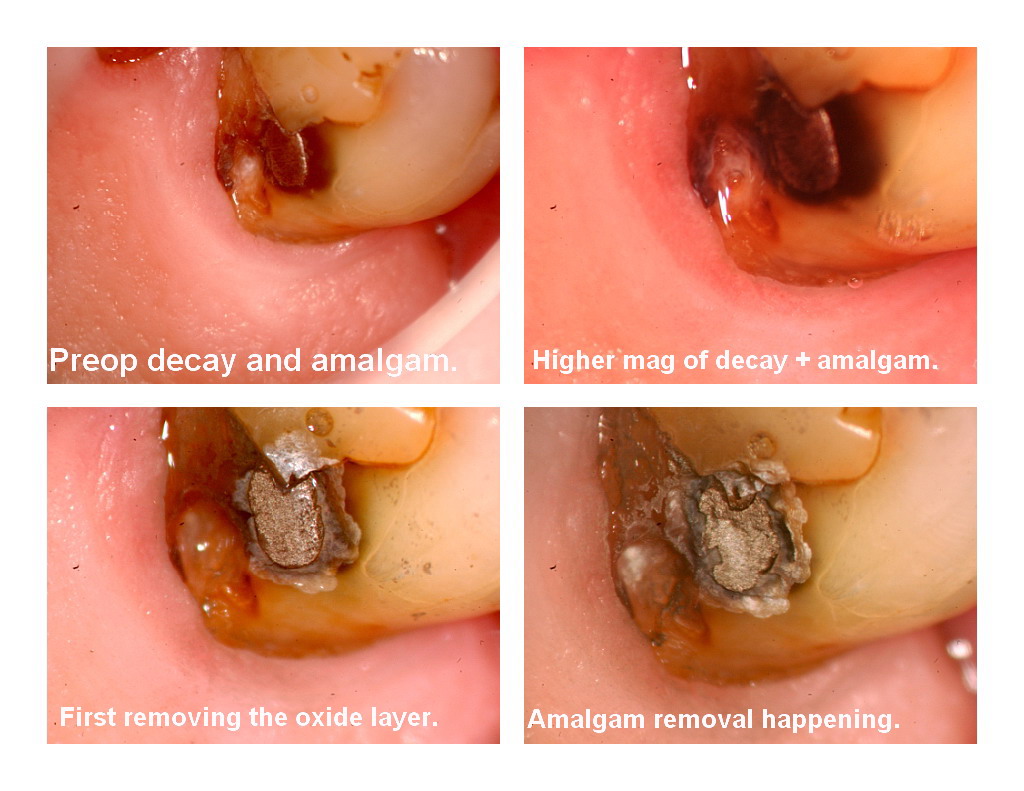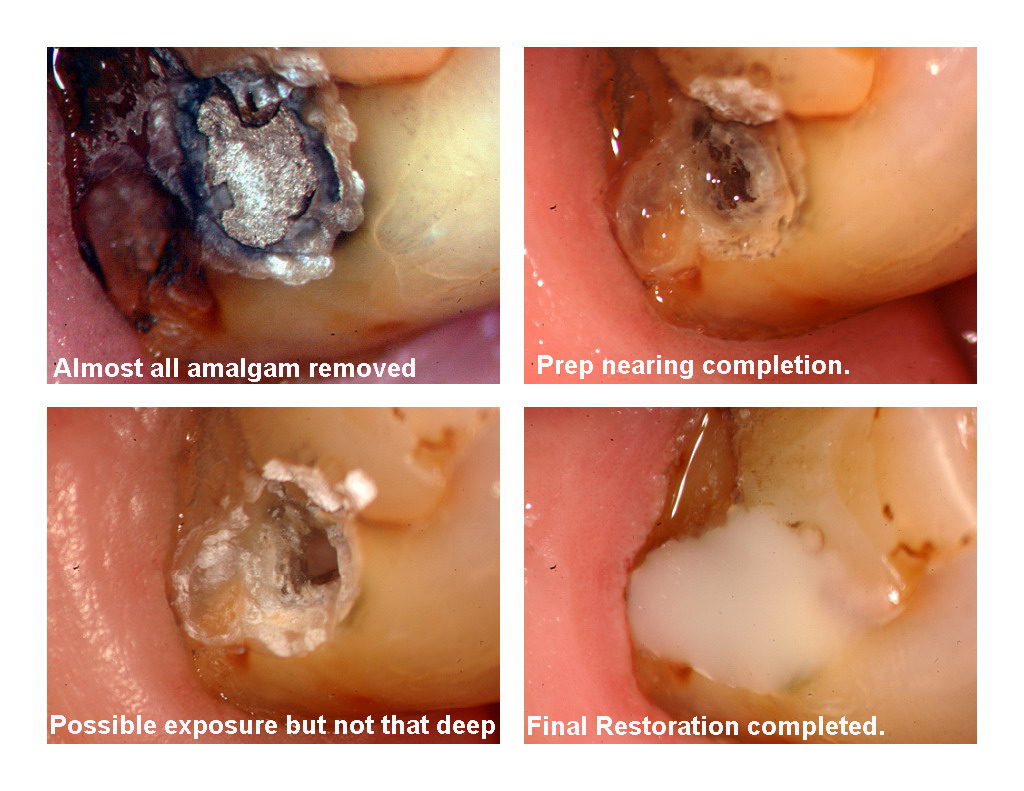Forums › Erbium Lasers › General Erbium Discussion › Dont try this at home
- This topic is empty.
-
AuthorPosts
-
Glenn van AsSpectatorHi folks: Ever since I saw a video by Dr. Greider with his Er: YAG laser removing amalgam its been bothering me whether it was possible or not. The amalgam in his case was an old class V that looked very old. The video showed the laser tip on the DeLight getting dark but not chipping and he removed amalgam .
This patient consented for me to give it a try today. It was a very small amalgam adjacent to recurrent decay on the lingual of the upper 2nd molar at the tissue level.
It was tough getting good pics (my battery on my flash was shot) and so I apologize but I am telling you that nothing was fishy here at all. The photos are not edited or changed to make it appear that the amalgam was removed. I just had to lighten them because they were so dark.
Bill Greider used massive energy amounts (7.5 watts) , but I only used 4.8 watts with a 600 micron tip and massive water with very high volume next to it, stopping alot to askthe patient how they were doing.
It looked to me like a pulpal exposure when I got the old amalgam out but this patient is just in a maintain phase as soon he will have a partial denture replacing most posterior teeth (they are all periodontally involved).
I am recognize that for the Waterlase guys this is risky. I havent posted it on the general forum or DT as I think it is not something for the general public but it is definitely possible to remove the amalgam with the Delight laser if its an old amalgam.
I know this will generate some discussion but I am telling you the gods honest truth, it can remove amalgam.
Dont get your nose too bent out of joint. It was the first and only time to see if it was indeed possible.It is………..
Glenn


arrowsmithSpectatorHOLY COW!! I never thought it was possible. This may be a dumb question, by why is it risky for Waterlase users? What advantage does the Delight have over the Waterlase in this regard?
aaroN
Glenn van AsSpectatorHi Arrowsmith: For waterlase users there is the real risk because of the handpiece design of sparks frying the fiber. Working around metal is not the ideal for the Waterlase users.
I am not sure this is an advantage. ERic Bornstein pointed out the risks with working a laser around amalgam. This one was small, the tooth is condemned in the near future, and I tried to reduce the risk with water spray.
I hope that helps. The tip was dark but not chipped. In addition there was no anesthetic in this case so patient would have felt heat on the pulp (assuming its still vital).
There must be an OH portion to the amalgam, but this was legit.
Glenn
2thlaserSpectatordear Glen,
The question I have is it what angle did you hold the tip to the amalgam? Was it 90 degrees, or at an angle so you didn’t reflect the energy back into the tip? I think I can try this with the Waterlase, Straight handpiece. Just need a bit more information. Cool
Mark
Glenn van AsSpectatorHi Mark: Just back from Winnipeg lecturing. I actually varied the angle of approach from 90 degrees to angled. I started trying to go around the outside and then thought oh what the heck and went straight on.
There is some worry from folks on degradation of the fiber in doing this. I just wanted to let you know. I tried it once but will not do it anymore but wanted to show it is possible.
Hope that helps
Glenn
drjinglesSpectatorLike I need to tell you this…
but..
careful Marc…atleast with the right angle handpiece
the spark could blow out a mirror..but the straight…
there is no mirror acting as a
sacrificing buffer….
so
couldn’t the first spark fry the trunk
fibre directly?I havn’t used a straight handpiece yet..
ever..and thought…great….no mirror..
then realised that could be a mixed
blessing.drjingles
drjinglesSpectatorGlenn
did the amalgam fall out after the tooth
structure around it was undermined?I’ve done that with air abrasion
many times….and also used air
abrasion directly on the amalgam
and watched it slowly disappear..I’ve gone around amalgams
with the Waterlase shhhhhshshhbut not deliberately tried to
disentigrate or lase amalgam directly..I guess my real question is…
if you put a small piece of amalgam
on the bench…
and just started lasing at it..without any tooth structure around it..
would it slowly make the amalgam
disappear?I’ll bet there is a wavelength out there
or modification that would make this
a possibility in industry somewhere..but…
erbium by its nature likes stuff
with water content….and also has
an affinity for White stuff..neither of which seems to be a property
of most amalgams…I wonder if there would be a way in the future
to come up with something that works on
or is absorbed by and breaks up certain
phases of the amalgam…iemaybe it only works on the Eutectic stuff..
or something like that..
yikes…I must have stayed awake through
some of the DMS stuff afterall..
hmmm
not enough to sound like I know what
I’m talking about though….hehe..another possibility that just occured to me
is ….the appearance of shiny polished amalgam
vs….eroded or corroded rough stuff..
and the more you lase it or abrade it..
the more it takes on a lighter appearance
which might make it more responsive or
reactive to the erbium wavelength…eh…I’m dreaming…
drjingles
Glenn on the roadSpectatorHi Lawrie…….long time no hear. Hope things out your way are going great.
The amalgam did not fall out as I actually ablated it bit by bit until it came out. I didnt work around the outside of it, I just ablated it away. Its possible to do with the Delight but apparently if you do enough of it you will either
1. Significantly degrade the fiber.
2. Ruin tips (blacken them) or ruin the fiber.My Australian colleagues did some experimentation at the dental school (I think it was Melbourne) and discovered that the release of mercury in the vapour was not quite as high as expected but elevated to a similar degree as what one would expect with a handpiece (interesting I thought).
THe fear was that with time you would degrade the fiber enough to render it useless but the fiber wasnt failing catastrophically with the DeLight.
My friend Paul Baitus with Melbourne branch of Protec in Australia was the one who informed me of this on my recent trip. Great bunch of guys in Australia that work for Protec……super guys.
To answer your question…….YES THE AMALGAM WOULD DISAPPEAR.
I am sure that the work being done on sub pico lasers will cut eventually amalgams , crown preps etc faster.
Main problem I see is cost of production (250,000) and huge size of these units. I have seen some phenomenal SEM of how these cut precise preps of 1mm squares instantaneously and due to the unbelievable speed of ablation little heat is generated. You literally vaporize the tooth structure. Cool stuff.
Finally, I think that you may be right about the older amalgams being easier to remove with the laser. Dont know why but suspect that the composition is different. I dont think it is easy to remove the shiny non oxidized ones, but to be honest , I did it once and am not prepared to keep trying……..I will leave that up to the experts.
Glenn
N8RVSpectatorNice post, Glenn.
I’ve seen the same video you mentioned and the amalgam did indeed seem to ablate just like the surrounding tooth structure.
Just curious, however … are there possible mercury release considerations here? What are the effects of the laser energy on the amalgam — do we know? It might make an interesting study to compare the amounts (if any) of mercury vapor released when using a bur with the use of a laser.
Anyone know?
— Don
-
AuthorPosts
